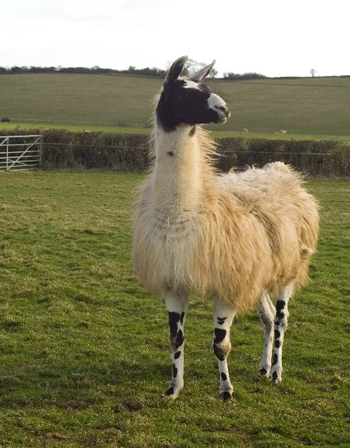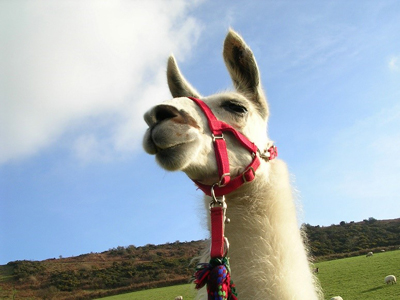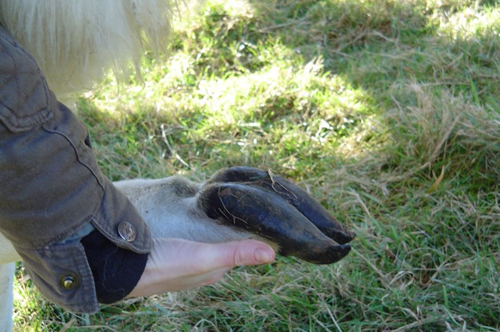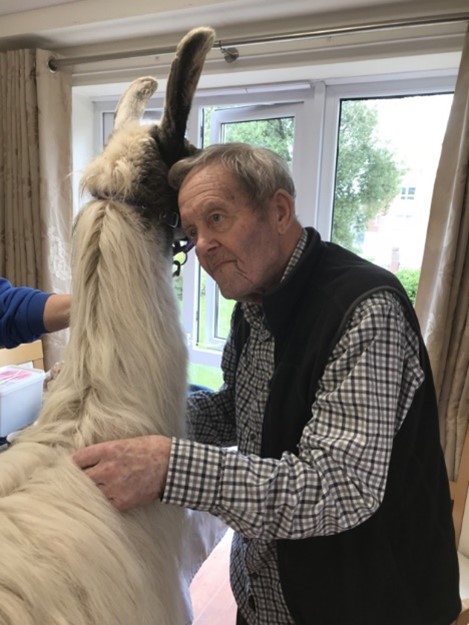

Adult llamas stand at about 4 feet at the shoulder, weigh 120-200 kg and can carry approximately 20-25% of their bodyweight. They have a lifespan of 15-25 years and come in a wide range of colours and markings - black, white, grey and all shades of brown. Unlike alpacas, most llamas have mixed colours - and they even come spotted.

They are similar to cashmere goats in that they have a double fleece. The upper layer is known as guard hair, which is course and aids in air circulation as well as acting as a water-repelling rain coat, while the underneath consists of soft down hair which acts as insulation against heat as well as cold. Their fleece stops at the top of the legs, with short hairs on the legs which help to disperse heat in the summer. Llamas normally moult twice a year and generally don't need shearing in the UK unless they have a particularly heavy fleece.
By comparison their smaller cousins, alpacas, just have a single fleece without guard hairs and this fleece extends right down the legs so they have no short hairs to help disperse heat. They don't moult so need to be sheared annually so that they don't overheat.

Llamas have a very dignified, almost aristocratic manner. They have excellent long-distance eyesight and view everything that they can see as part of their own territory!

They are alert, quick to learn and extremely inquisitive. They are also strong, stoic and extremely gentle. They do not bite as, like sheep and goats, they do not have any upper front teeth (incisors), just a hard pad. However, they do have both upper and lower grinding molars at the back of the mouth.
Llamas are herbivores and are "modified ruminants" - they have a three-chambered stomach and chew the cud (true ruminants like cows and sheep have a four-chambered stomach). As well as grazing, llamas like to browse in hedgerows (brambles are a particular delicacy!) They have an ingenious split upper lip, which working together with their lower incisors, is used to grasp forage and is very useful for picking out their favourite plants.

Llamas are very efficient at converting poor quality forage into protein and on average 4 llamas can be kept on 1 acre of land.
Like camels, llamas have two toes on each foot with a broad leathery pad underneath which helps to maintain grip on steep or rocky terrain. They also have curved nails on the front of each toe for added grip. Thus, they are very sure footed, and as they walk on pads rather than hooves, they do not damage the environment.

Half way up each back leg, inside and out, they have very strange looking oblong shaped bare patches - these are their metatarsal scent glands. It is assumed they are used for marking scent trails in the wild and also suspected to be associated with the production of alarm pheromones. Llamas have an additional scent gland which is located between the toes.

Although they are very hardy animals, being adapted to high altitudes and extremes of temperature, llamas should be provided with some type of shelter from the heat as well as the cold. They are herd animals and should not be kept on their own. Although they prefer the company of other llamas, they will often live quite happily with animals such as horses, donkeys, goats and sheep.
They all have very individual characters and their docile temperaments have a real calming effect, making them ideal walking companions and also excellent therapy animals.
Llamas have been in the UK for many years now. As they make excellent walking companions many are being used in llama trekking centres, and some, like our Harry and George are therapy animals, bringing joy into the lives of those in care homes, hospitals, etc.

Some llamas are kept as pets or as companions to animals such as horses or goats, and others are kept for their high-quality fibre (fleece). This fibre, although not generally as fine as that of alpacas, can be used for hand spinning, felting, and for fibre used in crafts. It is lightweight and warm, does not shrink and is naturally hypoallergenic (it has no lanolin).
Llamas are increasingly being used by farmers for guarding sheep or poultry as they have a natural guarding instinct and will chase off predators such as dogs or foxes. A Warwickshire farmer who had been suffering from frequent dog attacks on his 250 sheep reported that these attacks had completely stopped after the introduction of a guard llama.
Llama manure makes an excellent fertiliser. The pellets - sometimes known as "llama beans" are odourless. high in nitrogen, and can be put straight onto gardens without the need for composting - with no danger of burning plants.
"Dotheyspitdotheybitedotheykickwheredidyougetthemwhatareyougoingtodowiththem?!!" I found this on an American website as a "question" that a llama owner is constantly being asked - and when we are out and about with our llamas we are often stopped by passers-by and asked exactly the same thing!
The most common question that we get asked is "Do they spit?" The answer to this is, yes they do spit - but usually only at each other, or to defend themselves. Spitting is a natural form of defence and used to establish and uphold social order within the herd, as well as to settle disputes over food. Most disputes are resolved at the mere threat of a spit. Llamas do not normally spit at humans unless they are provoked.